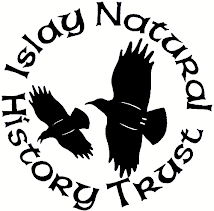In my other role as Keeper of honeybees for the Islay
Pollinator Initiative I have come to learn a great deal about flowers and
pollination, attentive to what is in flower and the value of each for the
honeybee. There is always a fall off of
pollen brought back by the bees and I collect up samples to have a closer look
and learn a little more about what they are really foraging on. Sheltering indoors with Saturday's rainy,
windy weather I finally had the chance to look through a scoop of pollen
collected from a hive a week or so back that did not make it through the queen
excluder the bees were moving through.
 As with all flowers different by colour, shape and texture,
so too are the pollen grains they produce.
Each pollen grain is essential for the plants to pass on to other
flowers of their own kind in order for fertilisation to occur and new progeny
in the form of seeds for plants to perpetuate their species. Flowers have built a very complex relationship
between themselves and various pollinators, butterflies, bees, wasps and
hoverflies to name the main contenders.
Pollen is food for some (our honeybees in particular) providing protein
and essential minerals and nutrients for the larvae to grow healthy and strong,
the flowers provide nectar, a sweet energy rich treat for some and an
enticement and reward for the insect which gets laden with pollen to transfer
to the next flower.
As with all flowers different by colour, shape and texture,
so too are the pollen grains they produce.
Each pollen grain is essential for the plants to pass on to other
flowers of their own kind in order for fertilisation to occur and new progeny
in the form of seeds for plants to perpetuate their species. Flowers have built a very complex relationship
between themselves and various pollinators, butterflies, bees, wasps and
hoverflies to name the main contenders.
Pollen is food for some (our honeybees in particular) providing protein
and essential minerals and nutrients for the larvae to grow healthy and strong,
the flowers provide nectar, a sweet energy rich treat for some and an
enticement and reward for the insect which gets laden with pollen to transfer
to the next flower.  Honeybees are very important in this process, each bee
concentrates on a particular flower so only visiting flowers of the same
species in successive trips and therefore only the right pollen is taken to the
next flower visited. Some is passed on
and some the bees pack into their pollen baskets (on their hind legs), each species
of pollen has a different colour so by watching what colour pollen they return
to the hive with you can get an indication of what flowers they are
harvesting. By observing what flowers
are in bloom you can also predict what they might be foraging on at each stage
in the year.
Honeybees are very important in this process, each bee
concentrates on a particular flower so only visiting flowers of the same
species in successive trips and therefore only the right pollen is taken to the
next flower visited. Some is passed on
and some the bees pack into their pollen baskets (on their hind legs), each species
of pollen has a different colour so by watching what colour pollen they return
to the hive with you can get an indication of what flowers they are
harvesting. By observing what flowers
are in bloom you can also predict what they might be foraging on at each stage
in the year.
This is my collection of pollens in the sample, collected
about the first half of May, two shades of yellow/orange a pale green and a
creamy/white. A pollen colour chart can
give an indication of pollen colour for the month and by making a microscope
slide and looking under magnification, shape and form can be seen and further
identification made.
 |
| Individual coffee bean shaped pollen grains |
Pollen 1 - pale creamy/yellow and under the microscope looks
very much like coffee grains. Using
colour, and knowing what is in flower and checking pollen ID features these are
Bluebell, worked hard by the bees as it provides a very good nectar source as
well as pollen.
Pollen 2 - khaki green and under magnification distinctly
triangular with circular features at the corners, ID features suggest Rosaceae
family, and as there is an apple tree at the apiary and the colour matches, so it
is from our apple tree which will bear lots of apples hopefully at the end of
the summer, if this wind hasn't ripped all the blossoms off!

 Pollen 3 - colour, a dull orangey yellow, looking at the
colour charts I might have put these last two the other way around, however
under magnification (although my cheap none-too high tech microscope shows none
to clear) definition is not that great, the small round, poorly defined grains
I put to be Dandelion.
Pollen 3 - colour, a dull orangey yellow, looking at the
colour charts I might have put these last two the other way around, however
under magnification (although my cheap none-too high tech microscope shows none
to clear) definition is not that great, the small round, poorly defined grains
I put to be Dandelion.
Such studies bring another level of understanding to the complex relationship between flower and pollinator. Once the current restrictions abate and normality ensues (whenever that will be?) we will have our microscopes available to look at pollens in the Nature Centre and we will get a more high resolution camera to take better pictures of the samples than my bargain Aldi/Lidl purchase of a few years back doesn't do justice to!
Fiona MacGillivray

























